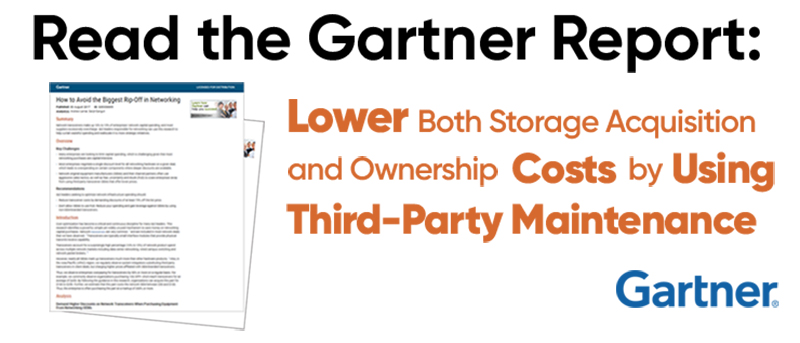IT leaders tasked with data storage management are turning to Third-Party Maintenance (TPM) in increasing numbers as they realize the many opportunities to optimize support strategies while reducing operational costs. In a research report entitled “Lower Both Storage Acquisition and Ownership Costs by Using Third-Party Maintenance,”1 Gartner details the different steps infrastructure and operations leaders should take to leverage independent, vendor-agnostic storage maintenance to the fullest.
As companies continue to transform parts of their businesses using digital technologies, they’re often faced with unprecedented spikes in data growth. Yet keeping pace with expanding storage needs doesn’t necessarily require a continuous cycle of upgrades to the newest storage products and platforms. Too often, “nice to have” new features don’t warrant a complete upgrade, which enables enterprises to extend the planned service lives of existing arrays simply by adding more capacity as needed.
There’s a lot to be gained from storage TPM, starting with cost savings of up to 70% off traditional maintenance contracts. Furthermore, extending the useful life of existing storage also can improve staff productivity. When it comes to performance, independent support options often include low-cost reconfiguration services, which can help alleviate storage bottlenecks and/or capacity limitations.
From the procurement standpoint, you can avoid time-consuming disruptions typical during upgrades while taking advantage of deflationary storage pricing. Independent support options offer greater flexibility when negotiating infrastructure upgrades with incumbent vendors, and the compelling economic value proposition gets even more attractive if you also can delay the purchase of new arrays by redeploying existing storage assets.
What’s more, TPM helps reduce the value of storage maintenance waivers, which incumbents often invoke to make it financially difficult for new entrants to bid on a platform refresh or upgrade. By reducing the value of these restrictive waivers, TPM forces incumbents to provide transparent bids with more aggressive discounting. By having an independent solution provider in the mix, you level the playing field for new storage vendors to compete for your business.
Despite all these advantages, TPM is not without perceived risk, so it’s important to follow best practices for identifying ideal partners with a variety of robust offerings. One common concern that’s overblown by incumbents is the need to retain the manufacturer’s maintenance in order to receive software updates.
The reality is that most microcode updates drop dramatically by the time arrays are three or four years old, making the move to TPM far less of an issue. Solid candidates for TPM typically are storage systems with the most stable microcode and hardware release levels that are compatible with the rest of your hardware/software stack to reduce exposure to software bugs and compatibility issues.
For organizations with no prior TPM experience, a good first step is to identify non-mission-critical workloads that can be hosted on TPM-supported systems, followed by a careful evaluation of prospective independent support providers. Companies with their own global support organization and remote field operations will be best suited to deliver 24/7 onsite break/fix support. In reviewing TPM candidates, make sure to review all current support offerings, pricing models, parts accessibility, SLAs and track records of business success.
Introducing TPM to your data storage maintenance mix sends a clear message to manufacturers: Forced array upgrades will not be tolerated. Disrupting the status quo with TPM makes great economical and strategic sense, especially when your various storage systems are well positioned to be big benefactors.
1Gartner, Lower Both Storage Acquisition and Ownership Costs by Using Third-Party Maintenance, Stanley Zaffos, March 3, 2017. Gartner does not endorse any vendor, product or service depicted in its research publications, and does not advise technology users to select only those vendors with the highest ratings or other designation. Gartner research publications consist of the opinions of Gartner’s research organization and should not be construed as statements of fact. Gartner disclaims all warranties, expressed or implied, with respect to this research, including any warranties of merchantability or fitness for a particular purpose. GARTNER is a registered trademark and service mark of Gartner, Inc. and/or its affiliates in the U.S. and internationally, and is used herein with permission. All rights reserved.



